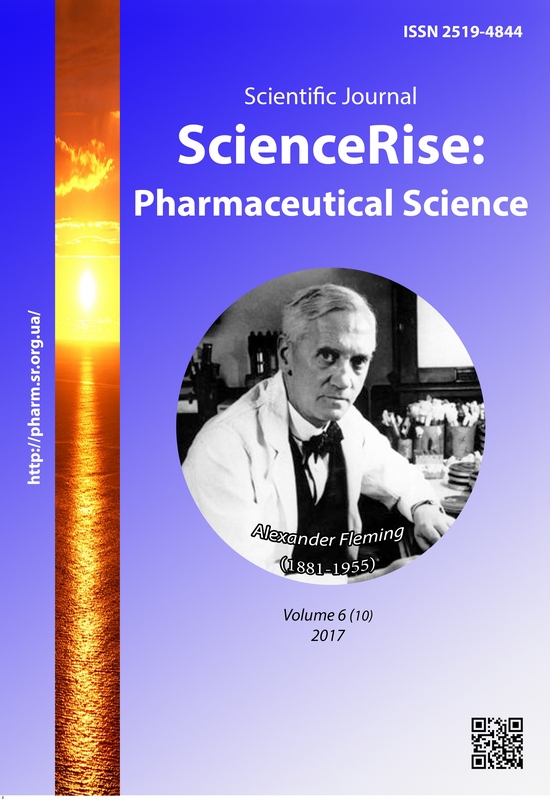Study of the composition of cryoprotector and technological regime in liophilization of liposomes with oxaliplatinum
DOI:
https://doi.org/10.15587/2519-4852.2017.118352Keywords:
Oxaliplatin, liposomes, high pressure extrusion, cryoprotectant, freeze dryingAbstract
Lyophilization is one of the most prospective and technologically logical methods for preserving the structure of nanobiotechnological products. Liposomes with oxaliplatin were obtained, and a screening experiment was performed to select a cryoprotectant.
Aim. The aim of the research is to obtain liposomes with oxaliplatin, determine the type of cryoprotectant and its quantity, study the parameters of lyophilisation to obtain the product with maximum encapsulation of oxaliplatin, with the save of the size of liposomes in the nano-diapason, and the optimum residual moisture content.
Methods. Lyophilization was carried out in a Quarco lyophilizer (PRC). The liposomal form of oxaliplatin was obtained by the method of "passive" encapsulation in combination with the ion sorption method.
Results. Lactose, sucrose, maltose and trehalose dihydrate were studied as cryoprotectants. As the most perspective, was chosen - trehalose dihydrate. The optimal concentration of trehalose dihydrate in the liposomal form of oxaliplatin was researched at 8 % by weight. Also was optimized the program of freeze-drying. Primary drying with a duration of 1740 minutes was not sufficient. When the program was increased for 300 min, up to 2040 min, the values of the loss of encapsulation rate of 8 %, from 65 % before drying, to 57 % after drying were obtained. This is a good indicator, which shows an effectiveness of cryoprotectant and a rational program of freeze-drying. The size of the liposomes after drying was 112 nm, the residual moisture content, measured by K. Fischer's method, was 2.3 %, which is within the scope of the target range.
Conclusion. A technology for obtaining liposomes with encapsulated oxaliplatin has been proposed and screening studies have been carried out to determine the optimal cryoprotectant. It is proposed to use as a cryoprotector trehalose dihydrate as the most perspective. The effect of different content of trehalose dihydrate on the degree of encapsulation of oxaliplatin in liposomes was studied. It was found that the optimal cryoprotectant concentration in the preparation is 8 % (by mass).
Technological parameters of the lyophilization process of liposomes with oxaliplatin have been developed: drying time and freezing temperature. The decrease in the incorporation of oxaliplatin into liposomes during lyophilisation did not exceed 8.0 % with a residual water content of about 2.3 %. The size of liposomes after lyophilization in the nanoscale is 112 nm
References
- Sharma, A., Sharma, U. S. (1997). Liposomes in drug delivery: Progress and limitations. International Journal of Pharmaceutics, 154 (2), 123–140. doi: 10.1016/s0378-5173(97)00135-x
- Bajetta, E., Beretta, E., Bartolomeo, M. D., Cortinovis, D., Ferrario, E., Dognini, G., Toffolatti, L. et. al. (2004). Efficacy of treatment with irinotecan and oxaliplatin combination in FU-resistant metastatic colorectal cancer patients. Oncology, 66 (2), 132–137. doi: 10.1159/000077439
- Shvets, V. I., Krasnopolskiy, Yu. M. (2008). Liposomyi v farmatsii. Produktyi nanobiotehnologii [Liposomes in pharmacy. Products of nanobiotechnology]. Provizor, 3, 18–24.
- Torchilin, V. P., Weissig, V. (2003). Liposomes: A Practical Approach. New York: Oxford University Press, 384.
- Chen, C., Han, D., Cai, C., Tang, X. (2010). An overview of liposome lyophilization and its future potential. Journal of Controlled Release, 142 (3), 299–311. doi: 10.1016/j.jconrel.2009.10.024
- Wang, W., Mo, C., Guohua, C. (2012). Issues in freeze drying of aqueous solutions. Chinese Journal of Chemical Engineering, 20 (3), 551–559. doi: 10.1016/s1004-9541(11)60218-8
- Franks, F., Auffret, T. (2007). Freeze-Drying of Pharmaceutical and Biopharmaceuticals. London: RSC Publishing, 206. doi: 10.1039/9781847557704
- Chen, G., Wang, W. (2007). Role of freeze drying in nanotechnology. Drying Technology, 25 (1), 29–35. doi: 10.1080/07373930601161179
- Stadnichenko, A. V., Krasnopolskiy, Yu. M., Shvets, V. I. (2015). Razrabotka i validatsiya metodiki opredeleniya stepeni inkapsulyatsii irinotekana gidrohlorida v liposomyi [Development and validation of the procedure for determining the degree of encapsulation of irinotecan hydrochloride in liposomes]. Biofarmatsevticheskiy zhurnal, 7 (1), 53–55.
- Stadnichenko, O. V., Krasnopolskiy, Yu. M., Yarnih, T. G. (2016). Vivchennya vplivu zaryadu lipidnoyi membrani pri stvorenni liposom iz oksaliplatinom [Study of the influence of the lipid membrane in the treatment of liposomes with oxaliplatin]. Vistnik farmatsiyi, 4, 34–37.
Downloads
Published
How to Cite
Issue
Section
License
Copyright (c) 2018 Alexander Stadnychenko, Yuriy Krasnopolskiy, Tatyana Yarnykh

This work is licensed under a Creative Commons Attribution 4.0 International License.
Our journal abides by the Creative Commons CC BY copyright rights and permissions for open access journals.








